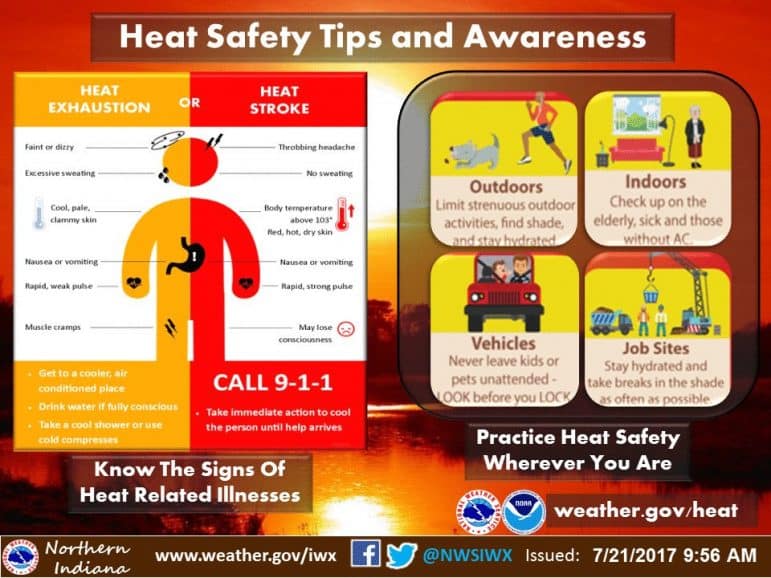Ghaziabad's Heat Advisory: Safety Guidelines For Outdoor Workers In Noida

Table of Contents
Understanding the Risks of Heatstroke in Ghaziabad and Noida
The climate in Ghaziabad and Noida, characterized by high temperatures and humidity during the summer months, creates a heightened risk of heat-related illnesses. Heatstroke, heat exhaustion, and heat cramps are serious conditions that can have severe consequences, even death, if not addressed promptly. While precise statistics for heat-related illnesses in these specific areas might be difficult to pinpoint without dedicated research, reports from similar regions in India show a significant increase in such cases during heatwaves.
-
Symptoms of heat-related illnesses:
- Heatstroke: High body temperature (above 103°F), confusion, seizures, loss of consciousness. This is a medical emergency.
- Heat exhaustion: Heavy sweating, weakness, dizziness, headache, nausea, muscle cramps.
- Heat cramps: Muscle pains and spasms, usually in the legs and abdomen.
-
Risk Factors: Certain populations are more vulnerable to heat-related illnesses:
- Elderly individuals
- Pregnant women
- People with chronic illnesses (heart disease, diabetes)
- Those working strenuously outdoors
-
Importance of Early Recognition and Treatment: Early recognition of symptoms is crucial. Delaying treatment can lead to severe complications. Seek immediate medical attention for any signs of heatstroke.
Protective Measures for Outdoor Workers in High Temperatures
Protecting outdoor workers from the harsh Ghaziabad and Noida heat requires a multi-pronged approach focusing on appropriate clothing, hydration, rest, and acclimatization.
-
Clothing: Wear light-colored, loose-fitting, and breathable clothing to reflect sunlight and allow for better ventilation. Consider using moisture-wicking fabrics.
-
Hydration: Adequate hydration is paramount. Workers should drink plenty of water throughout the day, even before they feel thirsty. Electrolyte drinks can also be beneficial, especially during prolonged exertion. Aim for at least 8-10 glasses of water per day, and more if working strenuously.
- Recommended Hydration Schedule: Drink water every 15-20 minutes, especially during intense work periods.
-
Scheduled Breaks: Regular breaks in shaded or air-conditioned areas are essential. These breaks should be frequent enough to prevent overheating.
- Optimal Break Frequency: Take a 10-15 minute break every hour for strenuous work, adjusting frequency based on work intensity and environmental conditions.
-
Protective Gear: Utilize additional protective gear:
- Wide-brimmed hats to shade the face and neck.
- Sunglasses to protect the eyes from the sun's glare.
- Sunscreen with a high SPF to protect the skin from sunburn.
-
Heat Acclimatization: Gradually increasing exposure to heat allows the body to adapt, reducing the risk of heat-related illnesses.
Employer Responsibilities and Workplace Safety Protocols
Employers have a legal and ethical responsibility to ensure the safety and well-being of their outdoor workers. This involves implementing comprehensive heat safety protocols.
-
Legal Requirements: While specific legislation may vary, most jurisdictions have guidelines or regulations regarding workplace safety in extreme heat. Employers should familiarize themselves with all applicable regulations.
-
Workplace Safety Protocols:
- Provide access to adequate shade during breaks.
- Ensure readily available access to cool drinking water.
- Establish a first-aid station equipped to handle heat-related emergencies.
- Implement a system for monitoring heat levels and adjusting work schedules accordingly.
-
Heat Safety Training: Provide mandatory heat safety training to all employees, covering the risks of heatstroke, preventative measures, and emergency procedures.
-
Communication Plan: Develop a clear communication plan for emergencies, ensuring prompt response and access to medical assistance.
Seeking Medical Attention for Heat-Related Illnesses
Immediate medical attention is crucial for anyone experiencing symptoms of heatstroke.
-
Emergency Contact Numbers: Keep emergency contact numbers for ambulances and hospitals readily available.
-
Responding to Heatstroke:
- Move the person to a cool place.
- Remove excess clothing.
- Apply cool compresses or a cool bath.
- Monitor vital signs.
-
Seek Medical Attention: Seek professional medical help immediately, even for seemingly milder symptoms. Early intervention can prevent serious complications.
Conclusion:
This Ghaziabad heat advisory underscores the critical need for proactive heat safety measures for outdoor workers in Noida and surrounding areas. By understanding the risks of heatstroke, implementing protective measures, and adhering to responsible workplace protocols, we can create safer working environments. Both employers and employees must remain vigilant in following these guidelines to prevent heatstroke and protect the health and well-being of all outdoor workers. Stay informed about the Ghaziabad heat advisory and take necessary precautions to combat the extreme summer temperatures. Prioritizing Noida heat safety is not just a suggestion; it's a necessity.

Featured Posts
-
 Leonardo Di Caprios New Spy Thriller Now On Netflix
May 13, 2025
Leonardo Di Caprios New Spy Thriller Now On Netflix
May 13, 2025 -
 Electric Vehicle Competition Heats Up Byd Vs Ford In Brazil
May 13, 2025
Electric Vehicle Competition Heats Up Byd Vs Ford In Brazil
May 13, 2025 -
 Doom The Dark Ages Early Access Regional Release Times And Full Game Launch
May 13, 2025
Doom The Dark Ages Early Access Regional Release Times And Full Game Launch
May 13, 2025 -
 Your Source For Efl Highlights Live Updates And Replays
May 13, 2025
Your Source For Efl Highlights Live Updates And Replays
May 13, 2025 -
 Gov Abbott Issues Cease And Desist Order Regarding Epic City Development
May 13, 2025
Gov Abbott Issues Cease And Desist Order Regarding Epic City Development
May 13, 2025
